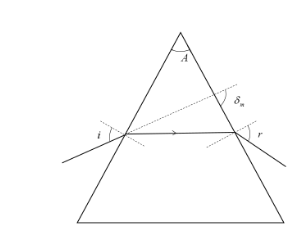
For the angle of minimum deviation of a prism to be equal to its refracting angle, the prism must be made of a material whose refractive index:
\[A)\] Lies between \[\sqrt{2}\] and \[1\].
\[B)\] Lies between \[2\] and \[\sqrt{2}\].
\[C)\] Is less than \[2\].
\[D)\] Is greater than \[2\].
Answer
575.7k+ views
Hint: Firstly we need to draw a diagram to understand the situation clearly. We will use the equation to find the refractive index of a prism and substitute the given situation of angle of minimum deviation in the expression and hence obtain an equation for the refractive index. Then we will apply the limit from \[0{}^\circ \] to \[90{}^\circ \] and obtain the range of refractive index which we could have using the given angle of minimum deviation.
Formula used:
\[\mu =\dfrac{\sin \dfrac{\left( A+{{\delta }_{m}} \right)}{2}}{\sin \dfrac{A}{2}}\]
Complete step by step answer:
We will draw the diagram using the parameters, angle of prism as (\[A\]), angle of incidence (\[i\]), angle of refraction (\[r\]) and angle of minimum deviation (\[{{\delta }_{m}}\]).

It is given that angle of minimum deviation to be equal to the refracting angle.
\[\Rightarrow {{\delta }_{m}}=A\]
Now, we will substitute this in the equation to find the refractive index of prism and it will become,
\[\mu =\dfrac{\sin \dfrac{\left( A+A \right)}{2}}{\sin \dfrac{A}{2}}=\dfrac{\sin \left( A \right)}{\sin \dfrac{A}{2}}\]
Now, we will use the trigonometric relation \[\sin \left( x \right)=2\sin \left( \dfrac{x}{2} \right)\cos \left( \dfrac{x}{2} \right)\].
\[\Rightarrow \mu =\dfrac{\sin \left( A \right)}{\sin \dfrac{A}{2}}=\dfrac{2\sin \left( \dfrac{A}{2} \right)\cos \left( \dfrac{A}{2} \right)}{\sin \left( \dfrac{A}{2} \right)}\]
\[\mu =2\cos \left( \dfrac{A}{2} \right)\]
So, we have the expression for a refractive index.
Now we will apply the limit for angle of prism from \[0{}^\circ \] to \[90{}^\circ \]. Then, if \[A\] is \[0{}^\circ \],
\[\mu =2\cos \left( \dfrac{0}{2} \right)=2\]
And if \[A\] is \[90{}^\circ \], \[\mu =2\cos \left( \dfrac{90}{2} \right)= 2\cos \left( 45 \right)=\sqrt{2}\]
So, we can conclude that the prism could have a refractive index which lies between \[2\] and \[\sqrt{2}\].
So, the correct answer is “Option B”.
Note:
The soul of this question is situated at the part where we are applying the limit for \[A\].
There we are taking the angles \[0{}^\circ \] to \[90{}^\circ \] because they are the maximum and minimum angles which a prism could have. We are taking \[{{\delta }_{m}}=A\] because if the minimum deviation is equal to refracting angle, by geometry, the angle of prism and the refracting angles will be equal.
Formula used:
\[\mu =\dfrac{\sin \dfrac{\left( A+{{\delta }_{m}} \right)}{2}}{\sin \dfrac{A}{2}}\]
Complete step by step answer:
We will draw the diagram using the parameters, angle of prism as (\[A\]), angle of incidence (\[i\]), angle of refraction (\[r\]) and angle of minimum deviation (\[{{\delta }_{m}}\]).

It is given that angle of minimum deviation to be equal to the refracting angle.
\[\Rightarrow {{\delta }_{m}}=A\]
Now, we will substitute this in the equation to find the refractive index of prism and it will become,
\[\mu =\dfrac{\sin \dfrac{\left( A+A \right)}{2}}{\sin \dfrac{A}{2}}=\dfrac{\sin \left( A \right)}{\sin \dfrac{A}{2}}\]
Now, we will use the trigonometric relation \[\sin \left( x \right)=2\sin \left( \dfrac{x}{2} \right)\cos \left( \dfrac{x}{2} \right)\].
\[\Rightarrow \mu =\dfrac{\sin \left( A \right)}{\sin \dfrac{A}{2}}=\dfrac{2\sin \left( \dfrac{A}{2} \right)\cos \left( \dfrac{A}{2} \right)}{\sin \left( \dfrac{A}{2} \right)}\]
\[\mu =2\cos \left( \dfrac{A}{2} \right)\]
So, we have the expression for a refractive index.
Now we will apply the limit for angle of prism from \[0{}^\circ \] to \[90{}^\circ \]. Then, if \[A\] is \[0{}^\circ \],
\[\mu =2\cos \left( \dfrac{0}{2} \right)=2\]
And if \[A\] is \[90{}^\circ \], \[\mu =2\cos \left( \dfrac{90}{2} \right)= 2\cos \left( 45 \right)=\sqrt{2}\]
So, we can conclude that the prism could have a refractive index which lies between \[2\] and \[\sqrt{2}\].
So, the correct answer is “Option B”.
Note:
The soul of this question is situated at the part where we are applying the limit for \[A\].
There we are taking the angles \[0{}^\circ \] to \[90{}^\circ \] because they are the maximum and minimum angles which a prism could have. We are taking \[{{\delta }_{m}}=A\] because if the minimum deviation is equal to refracting angle, by geometry, the angle of prism and the refracting angles will be equal.
Recently Updated Pages
Basicity of sulphurous acid and sulphuric acid are

Master Class 12 Business Studies: Engaging Questions & Answers for Success

Master Class 12 Economics: Engaging Questions & Answers for Success

Master Class 12 English: Engaging Questions & Answers for Success

Master Class 12 Maths: Engaging Questions & Answers for Success

Master Class 12 Social Science: Engaging Questions & Answers for Success

Trending doubts
Differentiate between homogeneous and heterogeneous class 12 chemistry CBSE

When was the first election held in India a 194748 class 12 sst CBSE

December 10th of 1948 is an important day in the history class 12 sst CBSE

Prove that a parallelogram circumscribing a circle-class-12-maths-CBSE

The computer jargonwwww stands for Aworld wide web class 12 physics CBSE

What is the Full Form of PVC, PET, HDPE, LDPE, PP and PS ?




